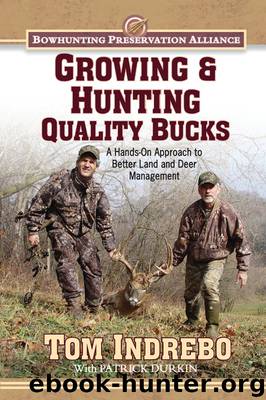Growing & Hunting Quality Bucks by Tom Indrebo

Author:Tom Indrebo
Language: eng
Format: epub
Publisher: Skyhorse Publishing
Published: 2013-03-04T16:00:00+00:00
DOCUMENTING BUCK MOVEMENTS
Sometimes I can tell him about the buck’s seasonal whereabouts, and how, where and when we first identified him as a regular on our property. It’s even more fun to study the year-to-year changes in the buck’s body and antlers that we documented with our scouting and video cameras.
In fact, between those two sets of cameras, I believe we can pretty much inventory almost every buck using our Bone Creek property. We won’t see each buck every day, but we’ll see them often enough to get some sense whether they’ll hang around a few years. If we wanted, I’m confident we could selectively harvest some of those bucks that never seem to go anywhere. Then again, once you target specific bucks, the hunt’s degree of difficulty somehow multiplies.
Either way, in most cases, once a buck reaches his third autumn, he pretty much settles into his home area and stays there until he dies. I’ve been interested to read about recent university research that found similar patterns. Although there will always be exceptions because bucks are individuals, most bucks don’t stray far once they’ve chosen a home range. Even during the rut, most white-tailed bucks don’t wander endlessly the way some hunters have long assumed.
For instance, after chronic wasting disease was found 100 miles southeast of here in 2002, researchers at the University of Wisconsin-Madison live-trapped and radio collared a few bucks to monitor their travels and see how far they ranged at different times of the year. The region where the research was conducted isn’t much different from my area in terms of habitat and hunting pressure.
The common thought is that bucks disperse more readily at age 1½ or 2½ and spend most of their year in one area, but then range far and wide during the rut. In the early stages of the Madison research, that assumption didn’t hold up. The researchers detected tiny home ranges and short rut-related trips for all antlered bucks, no matter what their age. During the prerut, for example, yearlings with their first antlers stayed in home areas not even a half-square-mile in size, while older bucks stayed on home areas of similar size.
Travel distances increased during the rut, but not by much. The researchers had expected more wanderlust from older bucks during the rut, but it didn’t happen. Rutting yearling bucks roamed areas not much larger than a square mile, while mature bucks actually covered less than a square mile.
Interestingly enough, a well-known deer-research ranch in Texas reported similar findings: Dr. Mickey Hellickson radio-tracked the movements of more than 125 bucks at the King Ranch in Texas. He assumed the project would confirm that bucks older than age three travel farther than their younger subordinates. However, his assumptions didn’t hold up. For age groups as a whole, as age increases, travel actually decreases. The most active, farthest movements were from 2- and 3-year-old bucks.
Hellickson said that although most bucks remain loyal to an area once they’ve stopped dispersing at about age 2½, it’s impossible to cite an average size for home ranges.
Download
This site does not store any files on its server. We only index and link to content provided by other sites. Please contact the content providers to delete copyright contents if any and email us, we'll remove relevant links or contents immediately.
Sapiens: A Brief History of Humankind by Yuval Noah Harari(13108)
The Tidewater Tales by John Barth(12045)
Do No Harm Stories of Life, Death and Brain Surgery by Henry Marsh(6349)
Mastermind: How to Think Like Sherlock Holmes by Maria Konnikova(6270)
The Thirst by Nesbo Jo(5814)
Why We Sleep: Unlocking the Power of Sleep and Dreams by Matthew Walker(5677)
Sapiens by Yuval Noah Harari(4574)
Life 3.0: Being Human in the Age of Artificial Intelligence by Tegmark Max(4534)
The Longevity Diet by Valter Longo(4462)
The Rules Do Not Apply by Ariel Levy(3928)
The Body: A Guide for Occupants by Bill Bryson(3849)
The Immortal Life of Henrietta Lacks by Rebecca Skloot(3840)
Why We Sleep by Matthew Walker(3794)
Animal Frequency by Melissa Alvarez(3769)
Yoga Anatomy by Kaminoff Leslie(3724)
Barron's AP Biology by Goldberg M.S. Deborah T(3643)
The Hacking of the American Mind by Robert H. Lustig(3595)
All Creatures Great and Small by James Herriot(3536)
Yoga Anatomy by Leslie Kaminoff & Amy Matthews(3419)
